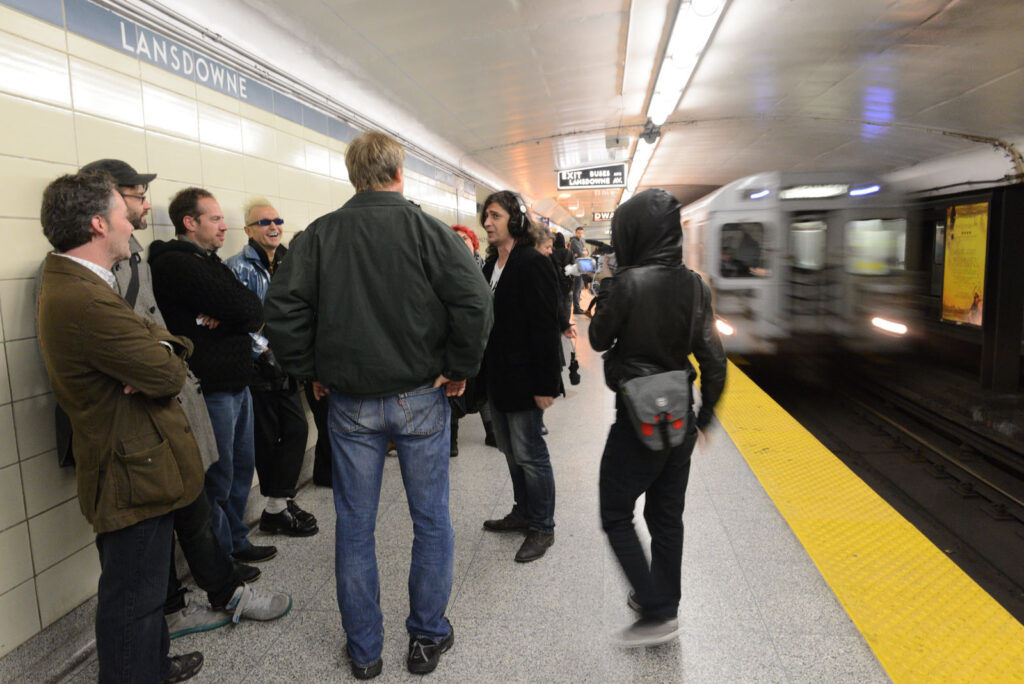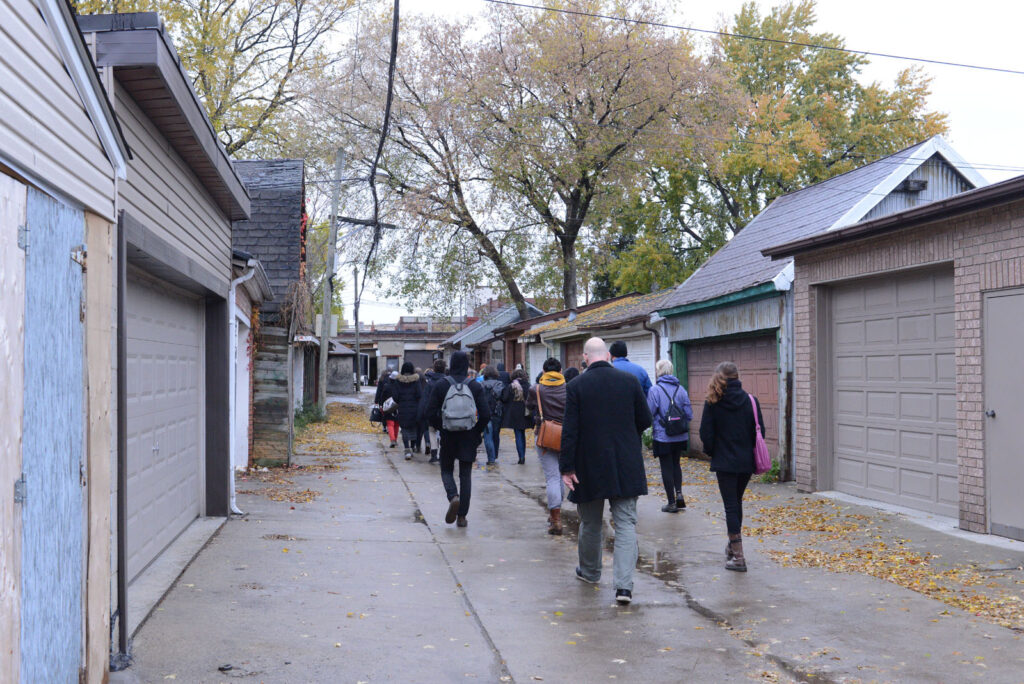By Randy Gledhill
Another recently embraced performative strategy is the relational group participation formula. This usually occurs from a pre-determined meeting point at a certain time. Once the contributing audience has gathered the ‘artist’ describes the ‘instructional’ conceit and proceeds to lead the band of people on some kind of journey or adventure.
7A*11D presented two such endeavors, each demanding its own rules of engagement.

First on Saturday, Denis Romanovski, the trickster (or perhaps post-trickster) from Minsk, met us at the 7A hot-spot Mercer Union. He wore giant headphones and spoke into a portable microphone. (I was later informed by the artist that through the headphones, he was listening to loud death metal music). Romanovski tipped us we were all going on a tour of ‘the museum’ and led us en mass into the Ossington Subway. Then came the first clue of what he was up to. He apologized that this “museum’, like most leading institutions, charged admission. We cued to pay our subway fare and ventured inside the lobby, where he announced that exhibition catalogues were available, and handed out copies of ‘Metro’ , the freely available daily street newspaper.
Relying on a deliciously skewed artspeak he offered grandiose interpretations of what was before us. Once on the subway platform, he described this as one of the largest museums in the world, though not as big as the sister museums in New York, Tokyo or London. We were informed that this museum also had satellite museums throughout the city and even mobile exhibitions linking them.
As museum animateur, he even Quoted Aristotle “The difference between history and poetry is that history describes what happened, while poetry invents that which might have happened”
Pointing to the large advertisements “Art talks about life, and this art says life is nothing”
To the information monitor “The museum includes media art”
To the subway map “Minimal abstraction”
The audience members are now engaged and responsive, goading on the next bon mot
“Is there a historical collection?”
“Is there a performance art program?”
He answers each question with interest, authority, knowledge and absurdity.
He herds us into a subway car. The mobile exhibition. Inside, as we whisk away, he welcomes us to a group exhibition.
“The artworks here are smaller, but more dynamic”
He points out a sign ‘Do not lean against glass’ “Instructional art”
‘Mind the gap’ “What does it mean?”
In the already crowded car, people are a bit disoriented. Is this for real? Perhaps an innovative new city cultural initiative.
We are led around to the other platform, heading back. The ridiculous banter continues unabashed.
Finally on the way out, we approach a concession stand. Of course, what is a museum without a gift shop? The chocolate bars and chewing gum are miniature multiples of the artworks we saw inside. Istvan was especially inspired by this installation. He asks if the store clerk is a performance artist?
“No, just another museum volunteer” states Romanovski, who then describes that he also is only a volunteer, and doesn’t get any payment from the museum director.
He rushes away, leaving us with the choice to enter back into the museum or exit to the streets. I decide, since I already purchased a museum ticket, to go back into one of the mobile exhibitions. My perception now distorted, fellow museum-goers perhaps wonder why I am sitting and looking about while chuckling to myself.
The second participatory tour was led the next day from the Toronto Free Gallery, across the street. Many attending audience returned from yesterday’s adventure. Artist Camille Turner instructed us to gather closely around her. Closer. Closer. We are informed quietly that, through her artwork SonicWalk, “We will visit familiar places for the first time, embracing strange and wonderful worlds that hide in plain view”. This proclamation seems strangely Masonic to me. We are gently requested to turn off our mobile devices and not to talk for the duration, to listen to the sound of the person next to us, to listen to our clothes, our heartbeat. and on the way outside, to listen to our footsteps.
Although I am sure it is conceptually paved in good intentions, this artwork for me relies on a series of problematic falsehoods. It is basically oxymoronic, as in ‘deafening silence’. Hearing, like bird watching can not succeed as a group experience, especially a boisterous, impatient group. When people gather together they are by nature programmed to communicate, to talk with each other and to make noise. Group silence is not liberation, but is more akin to a form of forced deprivation and control, as practiced in prisons or convents.
Hearing, unlike seeing cannot be controlled. Unlike our eyes, we cannot close our ears. We cannot focus our ears from far to close. (I believe this is one of Superman’s powers). We cannot filter out high tones or low tones. We are by nature binaural. We cannot listen to a tree, or a flower, or a person’s soul. We can only hear that which our ears indiscriminately collect. Whatever our intention.
And so I walked and listened.

On the street we are instructed to, as we walk, touch shoulders with the person beside us. Thankfully, what could have become an embarrassing faux bonding session is averted. Sylvie Ferré takes my arm. We silently proceed down Bloor Street. I recall a quite different voyage down the same street by Anna Katwajtys earlier in the week. As we turn the corner onto a residential street, we are asked to listen to the trees, the flowers. I begin to panic. Exit stage left. I make a quick departure down the first available alley, not daring to look back. I saw ‘Lost Horizons’ as a child.
Out of sight, or, er, out of sound of the herded crowd, I try to decide what to do next. I thought, I have already programmed myself for a Sonic Walk, and I have been generously engaged to write about the art, I should conduct my own tour in solitude. Instantly my hearing is awakened. And so I walk and listen.
I hear the sound of my feet hitting the wet pavement. My shoes plowing through the fallen autumn leaves. A breeze rustling the treetops. Children laughing. Raindrops hitting a trough. Everyone I cross is either talking to each other, or if alone, to their cellphone
I turn onto a busy main street. The sounds of cars whizz by. A big idling truck belches. Streetcar wheels screech around a corner on steel tracks. There is a blanket of distant freeway noise. An overhead flag flaps. I am indeed becoming familiar to places for the first time. I think again of bird watching. I try to search out a special sound, something exotic – perhaps a wind chime or a blind man’s cane.
Cold and damp, I enter a Tim Horton’s coffee shop. A cacophony greets me like a greasy cloud. Everyone is talking, talking, talking. A radio blares into nowhere. Some guy with a green beard sits down at the next table. He begins to run through all his ringtones, all his apps. It is very loud and very obnoxious. Unbearable. He won’t ever stop. I feel audio violated. I prepare to leave. The green beard guy stands up to look through the window for something outside. His cheap, wet sneakers squeak loudly on the tile floor. A woman enters to talk with the man. There is a lot of tension. I hear they are negotiating some kind of drug deal, or owed payment, or they are setting up a drop. I try not to listen to the sordid details. But I cannot block it out. Be careful what you listen for.
PR
